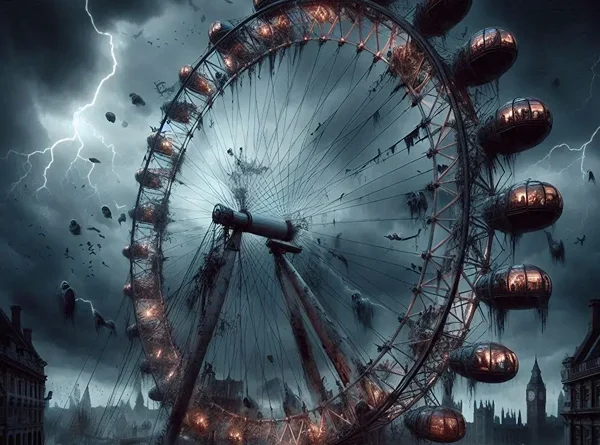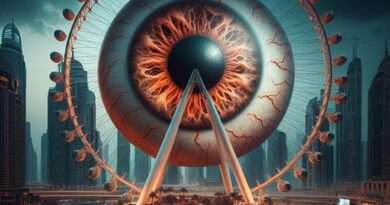The London Eye: Should You Watch Out From The Giant Ferris Wheel?
Some cities have a distinct symbol. London, the capital of England, has several such symbols: it is enough to mention The Big Ben clock tower, London Bridge or Buckingham Palace. In recent decades, a “new” attraction has been added to the city and now is associated with it: the enormous Ferris wheel, better known as The London Eye.
This Giant Ferris wheel of London, towering over the River Thames, is one of London’s most prominent tourist attractions – and this is not a simple thing, considering the city’s various tourist spots. It offers a spectacular view of the city and is impressive day and night, which may explain why about 3.75 million visitors arrive annually.
But since we are dealing with horror here, we need to ask whether the London Ferris wheel is also scary, or at least likely to create fear in those who suffer from the problem of fear of Ferris wheels. To answer this question, in the following review, we will introduce you to some interesting facts about the London Eye, discuss the story of its founding, explain its place in London’s cultural and tourist life, and see if you have anything to fear about.
What Is The London Eye?
The London Eye, or by its official name “Coca-Cola London Eye” (as part of a sponsorship agreement with the global beverage giant), is a giant observation wheel located in the heart of London, near some of the most prominent points of interest in the capital of the kingdom. More precisely, you can find it on the south bank of the Thames River, in a district called Lambeth, located in the heart of London’s entertainment and cultural area, the “South Bank.”
The central location of the London Eye allows you a spectacular panoramic view of the city, including famous landmarks such as the Palace of Westminster, Big Ben, St. Paul’s Cathedral, and much more. The proximity to the River Thames adds another dimension to the experience, as visitors can watch the boats and ships on the river.
On a clear day, you can see for about 40 kilometers, mainly because London is a relatively flat city. Even if you can’t see here forever on a clear day, the lucky ones among you can see, for example, the famous Windsor Castle, which we have already written about on the site. In any case, in more problematic weather conditions, the experience of the lungs may be affected, so we recommend scheduling your visit to the place for brighter days.
Many will recommend seeing the London Eye at night, with all the twinkling lights of the city from above, when the wheel itself is also beautifully lit (and even economically, with modern LED lights that are about 75% more economical, according to the operator).
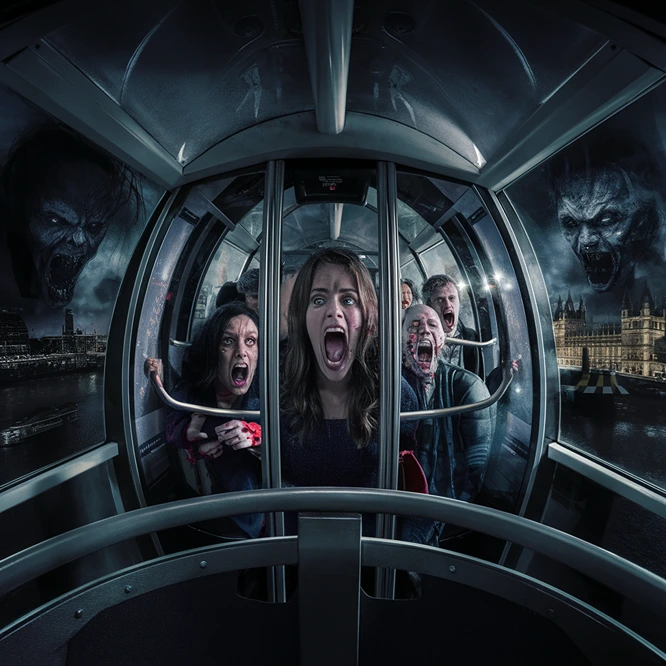
💀 Killer Deals & Scary Recommendations 💀
🎭 Costumes & Accessories
HalloweenCostumes Fun Costumes Entertainment Earth
🛒 Online Shopping
AliExpress Amazon Walmart Etsy
🧛 Collectibles & Horror Brands
Funko Hot Topic Lego Spirit Halloween
🎢 Attractions & Tours
GetYourGuide Tiqets Viator Klook
📖 Blogs & Horror Sites
Bloody Disgusting iHorror Fangoria
🩸 Disclaimer: Some links are affiliate links. The price stays the same – it just helps keep the site alive 👻
How Tall Is The London Eye?
With Ferris wheels, height is one of the most critical parameters. At 135 meters tall, the London Eye is the tallest structure in the western city of London. Until 2006, it was even the tallest Ferris wheel in the world. Since then, taller wheels have appeared – the “Sun of Moscow” (Koleso Obozreniya “Solntse Moskvy”) is currently the tallest in Europe, towering at 140 meters.
The record of the tallest Ferris Wheel across the globe has been broken several times, with the Star of Nanchang in the city of the same name in China (160 meters), the Singapore Flyer (165 meters), and the Eye of Dubai Ferris Wheel (“Ain Dubai”), which reaches an unimaginable height of 250 meters. By the way, Ain Dubai has not been operational for several years for safety reasons related to the subsidence of the earth, but that is a story for another article.
When Was The London Eye Built?
The London Eye was built in honor of the new millennium, that is, the beginning of the 2000s (in fact, one of its names is the “Millennium Wheel”). The idea for the wheel is said to have begun almost a decade earlier when David Marks and Julia Barfield first conceived the idea as part of a competition among architects to build a new London building for the millennium.
They planned to build a “21st century Eiffel Tower” in London. This spectacular structure would combine the English capital’s creativity, innovation, and technological capabilities while creating a new perspective on the city. Their choice of the shape of a car wheel is not accidental, as it is a traditional symbol of time and change. They believe it is the perfect shape to symbolize the new millennium in “a city that never rests.”
Although they ultimately did not win the competition, they continued to develop it, partly thanks to funding from the British airline “British Airways.” Construction of the London Eye began in 1998 and was officially unveiled to the public on December 31, 1999. It was not yet ready to receive visitors for various technical reasons, which happened only in March 2000.
The wait was worth it because, in the first two years of the London Eye, it received about 8.5 million visitors. This number is so impressive that the Londoners quickly decided to shelve their original plans, which were to dismantle the wheel after five years, and it towers over London to this day.
Here is a short video explaining the history of the London Eye:
The London Eye Facts In Numbers: Heavier, Slower
The London Eye is considered an impressive engineering achievement, so when discussing some unique London Eye facts, we must give it the spotlight. It stands out for its shape, which resembles a giant bicycle wheel (about 200 times larger than a regular bicycle wheel) supported on one side. The numbers say the builders used around 1,700 tonnes of British steel in its construction. The facility weighs 298 times more than all the major football stadiums in the English capital – of the teams Arsenal, Chelsea, Tottenham, West Ham, Fulham, and Charlton – combined. The total weight of the Ferris wheel is around 2,100 tonnes, equivalent to 1,272 black London taxis – and each of its capsules weighs around ten tonnes.
All of this requires, of course, careful planning to prevent instability and maintain safety under all conditions. The London Eye moving is at a speed of around 0.9 kilometers per hour, which means the wheel completes a rotation in around half an hour, so the pace here is very slow.
Unlike similar wheels, the London Eye does not stop: its ascent and descent are made while in motion, thanks to that slow pace. However, it is clear that when situations require it – for example, people with disabilities getting off or on one of the capsules – the operators will decide to stop the wheel.
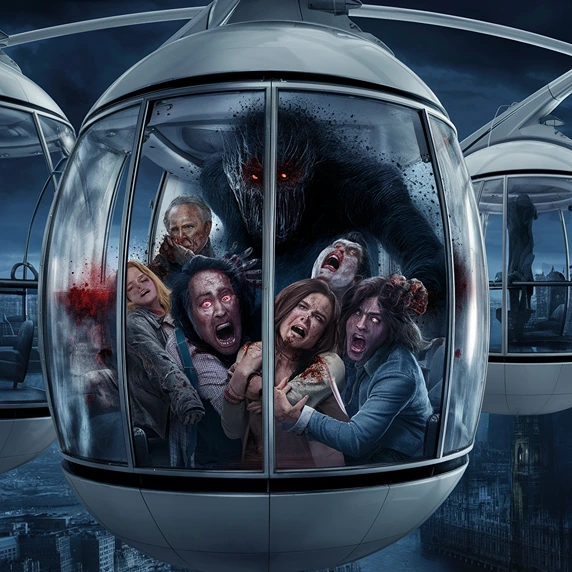
London Ferris Wheel? Technically, Not Exactly
According to the “dry” definitions, the London Eye is not exactly a Ferris wheel, even if it is round and large. As written on the official website of the London Eye, its capsules are entirely enclosed and climate-controlled, located outside the wheel structure, and completely motorized, conditions that do not exist in a “standard” Ferris wheel.
The entire structure is supported by an A-shaped frame on one side only, and this is probably not an accepted characteristic of a Ferris wheel either. Nevertheless, since we are not experts in engineering or Ferris wheels, we will follow the accepted concept and refer to the London Eye as (a kind of) Ferris wheel.
How Many Capsules Are On The London Eye?
The Ferris wheel in London consists of 32 closed capsules, with each capsule able to accommodate up to 25 passengers. In a straightforward calculation that I made using the computer’s calculator because I don’t trust myself even with elementary calculations, the maximum capacity of the wheel is something like 800 people.
The choice of 32 capsules is not accidental because there are 32 boroughs in London and its suburbs. The boroughs are numbered from 1 to 33, without the number 13, which was omitted due to the perception that it symbolizes bad luck.
Over the years, the capsules have undergone several changes and upgrades and can also mark special events. For example, in 2013, one of the capsules was renamed the “Coronation Capsule” to mark the 60th anniversary of the coronation of Queen Elizabeth II of England. In March 2020, as part of the facility’s 20th-anniversary celebrations, several capsules were transformed into themed experiences, such as a pub in a capsule, a theater capsule, or a “garden party” with flower arrangements representing the royal parks of the English capital.
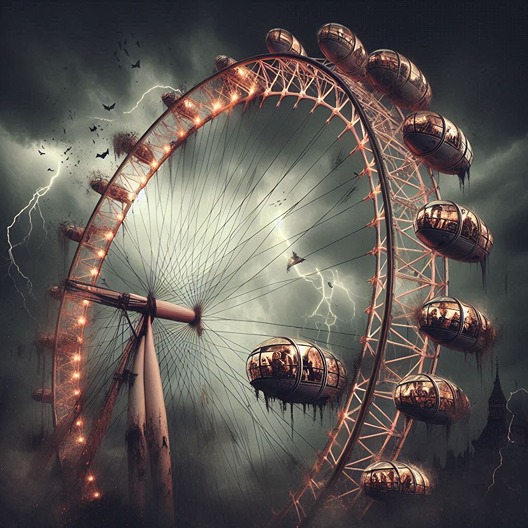
Is The London Eye scary?
If you also have traumas from squeaky or “too-rocky” Ferris wheels, the London Eye may be able to correct your impression a bit. In our review of the fear of Ferris wheels, we noted that it may combine several common fears expressed when climbing the facility, mainly fear of heights, enclosed spaces, or instability. These elements are also present in the London Ferris wheel, even if some would say in relatively small quantities.
The fear effect of the London Eye can be made up of the following triggers:
Height: The great height of the wheel (about 135 meters) may scare people with Acrophobia (fear of heights).![]()
![]() Capsules: The capsules are spacious, but still enclosed spaces. Therefore, it may be challenging for people with Claustrophobia
Capsules: The capsules are spacious, but still enclosed spaces. Therefore, it may be challenging for people with Claustrophobia
![]() Slow movement: The wheel’s slow rotation may cause discomfort or dizziness in some people.
Slow movement: The wheel’s slow rotation may cause discomfort or dizziness in some people.
![]() Transparency: The clear glass capsules are transparent, which may increase anxiety for people afraid of heights.
Transparency: The clear glass capsules are transparent, which may increase anxiety for people afraid of heights.
![]() Weather: The wheel’s movement may feel less stable on windy or cloudy days. Mainly for appearances, but there will be cases that have caused unpleasant and quite scary malfunctions for visitors (for example, this case)
Weather: The wheel’s movement may feel less stable on windy or cloudy days. Mainly for appearances, but there will be cases that have caused unpleasant and quite scary malfunctions for visitors (for example, this case)
![]() Technical malfunctions: Although rare, the fear of a technical malfunction that will cause the wheel to stop at a high altitude may worry some visitors.
Technical malfunctions: Although rare, the fear of a technical malfunction that will cause the wheel to stop at a high altitude may worry some visitors.
It is important to note that the London Eye is considered a very safe attraction, with advanced safety systems and meticulous maintenance. Most reviews describe a positive and exciting experience, with the disadvantages also mainly relating to the cost of the experience, queues, and so on. In our context, those afraid of Ferris wheels may also be afraid here, but on a relatively small scale.
How To Buy London Eye Tickets?
Ticket prices for the London Eye vary depending on the ticket type, the visitor’s age, and the purchase date. The rule of thumb is that booking in advance is likely to save you money since the price at the box office is higher than purchasing in advance online, whether on the attraction’s website or the ticket websites (as we will present soon).
Additionally, booking tickets in advance is recommended, even mandatory in the case of the London Eye. It can guarantee your place on the wheel even at busy times and save you the queues, which can be long here. The London Eye tickets that allow you to skip the queue will naturally be more expensive, but many believe the difference in experience is worth the investment in price. Buying a ticket in advance is essential, especially if you visit here during the peak months of the tourist calendar, on weekends, and so on (London is always busy, but there are even busier times).
The London Eye Prices
As of 2025, the price of the London Eye is:
🎫 Standard adult ticket (16+): from £29 when booked in advance
🎫 Child ticket (2-15) – about 50% cheaper than an adult ticket. Children under two years old enter for free
🎫 Fast Track tickets, which allow buyers to enter almost without waiting at the time of their choice or even at any time (Flexi Fast Track Ticket)
🎫 Deluxe package, which includes skip-the-line access, a souvenir booklet, and a photo of the visitors
🎫 Variable packages, often to mark special events
Some tickets combine several attractions so that the relative price of each is cheaper than purchasing them separately. These packages include:
![]() The London Eye and Thames River Cruise Combo Ticket
The London Eye and Thames River Cruise Combo Ticket
![]() The London Eye and Madame Tussauds Wax Museum Combo Ticket, which can also be a good fit for horror fans
The London Eye and Madame Tussauds Wax Museum Combo Ticket, which can also be a good fit for horror fans
![]() The London Eye, Madame Tussauds, and London Dungeon Combo Ticket (recommended for horror fans!)
The London Eye, Madame Tussauds, and London Dungeon Combo Ticket (recommended for horror fans!)
![]() The London Eye and Dungeon Combo Ticket
The London Eye and Dungeon Combo Ticket
![]() The London Eye, Madame Tussauds, and London Aquarium Combo Ticket
The London Eye, Madame Tussauds, and London Aquarium Combo Ticket
The London Eye Opening Hours
The London Eye is open almost all year round, except for a few days for annual maintenance. Its central location makes the London Eye very accessible for tourists and locals alike, with excellent public transport connections, including nearby tube and bus stations. Even if you don’t plan on visiting, you’ll likely see the wheel from a reasonable distance or at least looming over the London skyline.
The London Eye opening times may vary according to the seasons, and at the time of writing this article, it was open:
– Summer (April to the end of August): 10:00 am to 8:30 pm
– Winter (September to March): 11:00 am to 6:00 pm
During holidays or special events, operating hours may be extended. It is always a good idea to check the exact hours to avoid surprises on your arrival date.
How To Get To The London Eye?
Another advantage of the London Eye is its central location. As mentioned, the giant Ferris Wheel is standing on the south bank of the Thames and north of Westminster Bridge. This means many crucial points of interest in the English capital, such as the Palace of Westminster, Big Ben, and the British Parliament, are nearby.
Within easy reach, you will find other vital attractions in London, such as the beloved Aquarium, the London Dungeon, the Adventures of Shrek (not horror, but Shrek is at least a green monster), and more. Its location right on the Thames makes it accessible by boat as well, and you can certainly combine a cruise on the Thames before or after boarding the wheel.
Here you can find details of how to get to the London Eye using London’s (excellent) public transport.
The London Eye In Cinema: From The Fantastic Four To 28 Days Later
One of our favorite things is to see the references to sites, myths, or even objects in horror films. Beyond the tourist aspect and the architectural importance of the structure, it turns out that it may be considered a specific symbol… of romance.
There have been several London Eye weddings over the years, and the attraction’s brochure reports at least 5,000 marriage proposals in one of the capsules. I’m no expert on relationships, but it could be that the couple expects that even in bed, like on the London Eye, one spin inside a “capsule” will be slow and last about half an hour. Or maybe, just maybe, the London Eye is just romantic and quite suitable for marriage proposals.
Wow, how exciting. Anyway, we rummaged through our memory a bit, trying to find memorable horror scenes involving the London Eye, and we came away quite disappointed. We didn’t find any interesting insights on Google, except for perhaps a few scenes in the excellent “28 Days Later” and its sequel “28 Weeks Later,” which show apocalyptic London after a zombie attack. If you’ve seen zombie movies, you know to expect shots of the city being empty and messy, usually long shots or bird’s-eye shots to emphasize the emptiness, the loneliness of the survivor (Cillian Murphy, in this case), and so on. There’s nothing like showing the familiar symbols of each city – like London Bridge, Big Ben, and, of course, the London Eye – when they’re empty of people to symbolize the apocalypse, especially since, in this case, the shots look breathtaking. We hope to see more horror scenes or movies in the future to represent the scary sides of the London Eye more clearly.
We’ve seen scenes in which the London Eye has been present in several films, most of which unfortunately aren’t from our favorite genre: films like “Harry Potter and the Deathly Hallows,” the tennis comedy “Wimbledon” with Kirsten Dunst and Paul Bettany, or works aimed at a younger audience, like “Thunderbirds” and “Paddington Bear.” The facility has also had a place on television, including shows like “The Simpsons,” “Doctor Who,” “Sherlock and the Apprentice,“ and others.
The Fantastic Four (Fantastic?) London Eye Scene
The most significant scene starring the London Eye is probably in the rather forgettable 2007 film “Fantastic Four: Rise of the Silver Surfer.“ In the movie, the superheroes face off against some alien entity called the “Silver Surfer,“ who emits cosmic radiation to blow holes in all sorts of symbolic places worldwide.
One of these places is London, where our Marvels – equipped with special powers, effects, and wildly exaggerated acting – manage to prevent the London Eye from falling, with all its passengers, into the Thames. In my opinion, this scene and Jessica Alba are the only memorable things from this forgotten film.
The London Eye Mystery
Now, what if we told you that a person who enters one of the closed capsules of the London Eye could disappear, leaving no trace? This plot is at the heart of a children’s adventure book called “The London Eye Mystery“ by the decorated Irish author Siobhan Dowd, which is about two siblings: Ted, who suffers from Asperger’s syndrome, and his sister Kat. They try to investigate the disappearance of their cousin, Salim, from a capsule of the London Eye. The book won several important awards in the field of children’s literature and was, unfortunately, one of Dowd’s last before her death from breast cancer in 2007.
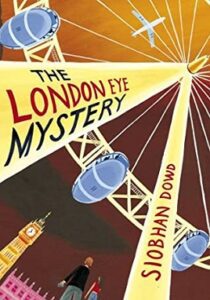
So, yes, there may be more scary attractions in London than the London Eye. Still, one of the UK’s favorite attractions is also very suitable for horror fans, especially those who fear heights or other phobias. And more importantly, you can’t miss it during a trip to London, can you?
Looking for other scary attractions in London? Try these options:
👻 London Is Waiting to Scare You 👻
Book tickets for the scariest experiences in London:
🩸 Disclosure: Some links are affiliates. It helps keep our site alive 👻

